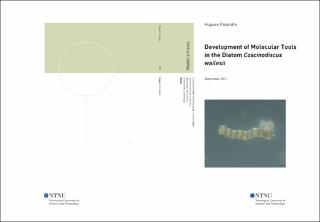Development of Molecular Tools in the Diatom Coscinodiscus wailesii
Master thesis
Permanent lenke
https://hdl.handle.net/11250/2832199Utgivelsesdato
2021Metadata
Vis full innførselSamlinger
Sammendrag
Þróun Sameindalíffræði tooes í kísilþörungar Coscinodiscus Wailesii kísilþörungars eru þekktir fyrirfjölmörg form og eyðublöð sem gefin eru af frumuveggnum sínum úr kísil sem heitir frustule. Þeireru einnig mjög mismunandi í stærð. Rannsóknir á erfðafræðilegum erfðafræðilegum köflum hefuraðallega lagt áherslu á litla kísil af hagnýtum ástæðum, svo sem genamengi, en einnig þægindi afstyttri kynslóð minni smærri frumna.
Þrátt fyrir að hafa lengri tvöföldunartíma, sinna stórum köflum tiltölulega hvað varðarlífmassaþéttleika og vöxt, sem gerir þeim góðan frambjóðandi tegundir til framleiðslu á iðnaðarmælikvarða. Þessir kostir gætu gert risastórt dísir góðar frambjóðandi tegundir til að mæla uppframleiðslu. Nauðsynlegt er að þróa aðferðir og þekkingu á risastórt kísilgen tjáningu til að gefalausan tauminn iðnaðar möguleika sína í náinni framtíð. Þessi aðalritgerð sem miðar að því aðbeita erfðafræðilegum verkfræði í C. wailesii með samskiptum í E. coli.
Þar sem tilraunir til að starfrækja samtengingar í Coscinodiscacae eru hingað til unreported, þurftiað hanna ræktun og valferli. Enn fremur, vegna vanhæfni til að vaxa C. wailesii á þýðingar,var nýtt í þýðingar rækun samskiptareglur þróað. Frá birtu erfðamengjafræði röð C. wailesii,mjög gefið upp verkefnisstjórar frá gen CwLHCF4-like og CwLHCFNew-1 voru notuð til að hannaepisomes. Plasmíðin fyrir samtengingu samanstanda af pCwPUC3Mut burðarás í tengslum viðverkefnisstjóra, terminator og sértækur merkisgen. Vandlátur genið er sett í plasmíðið, almenntble (zeocin). Fyrri tilraunir sýndu að C. wailesii getur ekki þolað styrkleika 50 g / ml af zeocin.
Frá og með í dag var ekki hægt að sýna samskipt DNA flytja milli baktería og C. wailesii. Skjaliðmiðar að því að veita skýringarmynd um hvernig á að þróa sameindaverkfæri í kísilum og hvetjaaðra rannsóknaraðila til að taka við verkefninu með því að nota upplýsingarnar sem uppgötvast áaðalritgerðinn Diatoms are known for their numerous shapes and forms given by their cell wall made of silicanamed frustule. They also differ significantly in size. The research on diatom genetics has mainlyfocused on small diatoms for practical reasons, such as genome size, but also the convenience ofshorter generation time of smaller cells. Despite having a longer doubling time, big diatoms performcomparatively in terms of biomass density and growth, making them good candidate species forindustrial scale production. Those advantages could make the giant diatoms good candidate speciesto scale-up production. It is necessary to develop methods and knowledge on the giant diatom geneexpression to unleash their industrial potential in the near future. This master thesis aimed toapply genetic engineering in Coscinodiscus wailesii by trans-kingdom conjugation from Escherichiacoli.
As attempts to operate conjugations in Coscinodiscacae are hitherto unreported, cultivation andselection processes had to be designed. Furthermore, due to the inability to grow C. wailesii onagar, a new in-agar culture protocol was developed.
From the published genomic sequence of C. wailesii, highly expressed promoters from the geneCwLHCF4-like and CwLHCFNew-1 were used to design the episomes. The plasmids forconjugation are composed of a pPtPUC3Mut backbone associated with the promoters, aterminator and a selective marker gene. The selective gene inserted in the plasmid, thecommonly use ble (zeocin). Previous experiments shown that Coscinodiscus wailesii cannottolerate a concentration of 50 μg/mL of zeocin.
As of today, the conjugative DNA transfer between bacteria and C. wailesii could not beingdemonstrated. The document aims to provide an explanatory protocol on how to develop moleculartools in diatoms and encourage other researcher to take over the project using the informationdiscovered during the master thesis.
